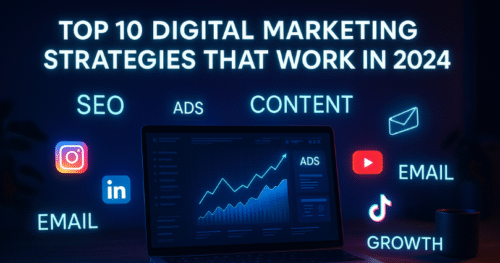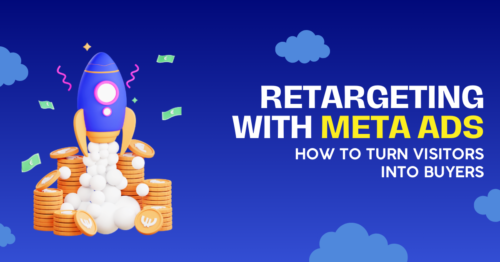For B2B lead generation, think coordinated system, not just one popular ad. You need to draw in the correct people, show you know your stuff, grab attention, sort out valuable leads, and pass on the best ones to sales. The best B2B digital marketing agencies, platform teams, and expert analysts use a combination of content that pulls people in, account-based strategies, data on customer interest, paid ads (especially on LinkedIn), automation with a personal touch, and careful tracking. Here’s a look at some effective strategies and how you can use them.
1. Put Content First, with SEO as the Key
The best marketers see their website and the content on it as the main way to get leads. Good content (like detailed guides, technical papers, real-world examples, interactive tools, and online events) gets search engines’ attention and shows that you’re an expert. SEO helps people find this content. Industry reports show that websites, blogs, and search engine traffic are still the best ways to get good returns for B2B businesses.
How to implement
- Create content that matches each step of the customer’s buying process: make them aware (how-to blogs, trend pieces), make the customer consider (comparison guides, webinars), and help them decide (case studies, ROI tools).
- Focus on keyword groups around what your customers need and the results you offer, instead of just product names.
- Reuse content: change a webinar into a whitepaper only accessible through a form, short clips for social media, and a series of emails.
Quick gains
- Each quarter, publish one main page and four related posts that answer important questions your potential customers are asking.
- Include obvious calls to action and special offers to turn high-performing pages into sources for marketing qualified leads.
2. Focus on Account-Based Marketing (ABM) and Intent Data
Since big B2B purchases usually involve several people and a lot of money, many companies add ABM to their inbound efforts. ABM concentrates on specific accounts by using custom ads, reaching out directly, and creating content just for them. More and more, teams are buying or finding intent data (what people search for, what content they look at) to spot accounts that are ready to buy and focus on them. This turns a lot of general leads into a smaller group of hot prospects. Experts say you should link your demand generation and ABM plans to get better results.
How to implement
- Figure out your ideal account profile (IAP) and find intent data sources (like what people do on your website or third-party data).
- Make a few custom resources for each target account, like a special mini-website, a custom audit, or a short report for executives.
- Make sure your sales development reps (SDRs) reach out in a way that matches your ad and content efforts.
3. Use LinkedIn and Paid Social Ads (and Keep Testing)
LinkedIn is a favorite ad option for B2B marketers. It lets you target certain people on a professional site. Good companies use LinkedIn ads and search ads based on what people are looking for to show useful content and case studies to those who make the decisions. The smartest teams try new things and aim for real conversions (good leads) instead of just looking at basic numbers. LinkedIn has tips on finding good leads and what kinds of ads work in B2B.
How to implement
- Start with a small group (based on company size, job, or industry) and offer something helpful.
- Use LinkedIn’s lead forms to gather info easily. Then, follow up with a few short emails.
- Track opportunities and pipeline results, not just the cost per lead, to see what works.
4. Build Multi-Touch Nurture Campaigns with Segmentation and Personalization
Getting a lead is only the start. The best companies use email campaigns, texts, bots, and progressive profiling to get leads ready to talk to sales. These programs mix automatic emails based on what people do with personal contact at certain times (like when a lead scores high, asks for a demo, or visits the site a lot). Many businesses use tools like HubSpot to handle this.
How to implement
- Use lead scoring that looks at both activity (content downloads, page visits) and fit (company size, industry).
- Design workflows with different paths. For example, if someone watches a product demo, send them to a sales rep quickly. If they only read blog posts, keep sending them educational content.
- Use personalization to change messages based on industry and job role.
5. Host great events & webinars, and convert attendees into sales opportunities
Webinars, online discussions, and hybrid events are great for getting leads, especially when you’re dealing with complicated business topics. They allow potential customers to see what you know and if your product is a good fit without feeling pressured. The best companies follow up after these events with recordings that people can only access if they take an action, surveys, and personalized emails to those who were really involved.
How to implement
- Team up with a partner or group in your industry to reach more people and build trust.
- Get people to sign up through email, LinkedIn, and your partner’s channels.
- Send different content to different groups right away, like a recording for everyone and sales emails for those who seemed very interested.
6. Use AI and Automation Wisely to Do More, but Don’t Sacrifice Quality
AI can really help marketing teams get more done by quickly drafting content, creating different versions of ads, predicting scores, and automating reports. Some teams are automating many regular marketing tasks but still have people in charge of strategy and messaging. Use AI to handle repetitive tasks, but always have a person review and add the final touches.
How to implement
- Use AI to create blog ideas, write different ad captions, or summarize webinar questions, but then edit them to add a human touch.
- Use lead scoring to find the leads that are most likely to turn into sales.
- Automate your reporting so your team can spend time improving things instead of just gathering data.
7. Track the Right Numbers: Sales Pipeline Influence, Deal Speed, and Customer Lifetime Value
The best B2B teams don’t just focus on the number of leads. They look at how many leads turn into opportunities, how quickly deals close, and how much value marketing brings to each deal. This means connecting your marketing systems to your customer relationship management (CRM) and using attribution to see which content and channels really create sales. Experts say it’s important to connect marketing metrics directly to revenue.
Essential KPIs
- The rate at which Marketing Qualified Leads (MQLs) turn into Sales Qualified Leads (SQLs)
- The value of the sales pipeline created and the percentage of the total pipeline that marketing influenced
- The cost per opportunity and the ratio of Lifetime value to Customer Acquisition Cost (LTV:CAC)
- The time it takes to close leads from different sources
8. Put Playbooks into Action: Fast, Keep What Works, Grow
Great providers create playbooks that can be repeated. This could be a tested campaign template, rules for what gets credit, how leads are passed on, and follow-ups with sales that are guaranteed by service level agreements. They do a lot of small tests, stick with what gives the best results, and automate the rest. This makes a lead engine that is predictable and can grow.
Checklist for Getting Started
- Make a landing page template that turns visitors into customers, and test different headlines and calls to action.
- Release a list every three months of what you want to test (one big idea and a few smaller tests).
- Write down the service level agreements for handing things off to sales: how fast they should respond, requirements for being qualified, and how feedback should be given.
Final Thought
The best B2B digital marketing providers use a mix of content and search engine optimization, account-based marketing with info on what people want, paid outreach on LinkedIn, automated nurturing, events, and making changes based on data. Now they’re adding AI to grow their work without dropping quality. Begin by checking what parts you already have (content, customer relationship management, paid channels) and try out one or two changes that will likely move the process along the fastest. For example, you could test account-based marketing with data on what people want with 10 accounts or a series of webinars tied to a product trial offer.







